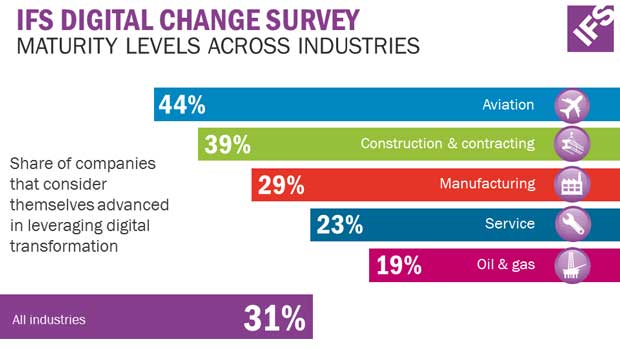01 Jun 2017 - {{hitsCtrl.values.hits}}

IFS, the global enterprise applications company,reveals the findings of its Digital Change Surveythat polled 750 decision makers in 16 countriesto assess maturity of digital transformation in sectors such as manufacturing, oil and gas, aviation, construction and contracting, and service.
Strong willingness to invest
Nearly 90 percent of firms surveyed have ‘adequate’ or ‘advantageous’ funding for digital transformation, indicating a strong willingness to invest and an appetite to evolve their business in order to stay competitive and grow. When asked about prioritized investment areas, the top three choices were IoT, ERP and Big Data & Analytics.
“It is apparent that companies today understand the urgency of focusing on digital transformation.”IFS VP of global industry solutions Antony Bourne said.
“Technologies such as big data and analytics, enterprise resource planning and internet of things are paramount to transforming a business. Companies need to apply innovative technologieshand in hand with their relevant industry expertiseto succeed and gain a competitive edge. It is this combination that makes digital transformation both meaningful and powerful”.
Lack of talented employees
Alarmingly, more than a third of companies (34percent) feel either slightly or totally unprepared to deal with digital transformation due to talent deficiency. When asked to name the areas that will experience the greatest deficit in talented staff, 40 percent cited “business intelligence” and 39 percent “cyber security”. Other areas of concern are ‘AI and robotics’ (30percent), ‘big data/analytics’ (24percent), and ‘cloud’ (21percent).
Antony Bourne added, “Although new technology is key to digital transformation, it is clear that change communications and access to the right talent are principal catalysts to succeed. It is alarming that more than one in three companies are not staffed to manage digital transformation. These organizations need to focus on concrete talent investment plans to make sure that they establish what roles are critical to success in their industries. After that the key is both to find and attract new talent as well as training and re-skilling existing staff.”
“Industrial IoT investments offer excellent ROI which is driving adoption,” stated ARC Advisory Group, VP Enterprise Software, Ralph Rio. He continued, “But, talent is a constraint as the IFS survey shows. Hence, IoT users partner with companies like IFS that offer leadership IoT solutions.”
Major differences across industries
When asked about the digital transformation maturity level of their organizations, meaning actual progress, 31percent of the respondents consider their business to be in the two highest levels of maturity on a five-graded scale. The aviation industry is the most progressive with 44 percent of respondents considering themselves advanced in their ability to leverage digital transformation. Runner up is the construction and contracting industry, 39 percent of whom identified themselves as mature. At the other end of the spectrum is the oil and gas sector, where only 19 percent of the respondents consider themselves able to benefit from digital transformation.
“The differences in digital maturity levels across industries are notable. The highly competitive nature of the aviation industry, together with its rapid adoption rate of new technologies such as predictive maintenance and 3D printing for spare part manufacturing, are key drivers of its successful digitalization”, Antony Bourne said.
Drivers and investment focus
43percent of respondents identified ‘internal process efficiency’ as the number one driving force behind digital transformation. ‘Accelerating innovation’ (29 percent) and ‘growth opportunity in new markets’ (28 percent) were recognized as the second and third most significant drivers.
Obstacles to digital transformation
Despite the practical and technical complexities of digital transformation, the number one barrier to change ison the human side: “aversion to change” (42percent). The second and third largest barriers are the more concrete “security threats/concerns” (39 percent) and “absence of the right organizational and governance model” (38percent).
Which will be the most disruptive technologies?
When asked what technologies will be the most disruptive, Big Data tops the list with a score of 7.2 out of 10. Second is Automation (7.0) and third is IoT (6.6).
Although Big Data is ranked the highest overall, there is a significant minority who feel that automation will have the most dramatic impact. Over 40percent rated the level of disruption by Automation as 8 or more out of 10, whileonly 32 percent gave such high ratings to Big Data. In the construction, aviation and manufacturing industries 48percent, 48percent and 50percent respectively consider the automation disruption score >8/10, which makes it the highest rated technology for those industries.
01 Jan 2025 2 hours ago
01 Jan 2025 3 hours ago
01 Jan 2025 3 hours ago
01 Jan 2025 3 hours ago
01 Jan 2025 3 hours ago